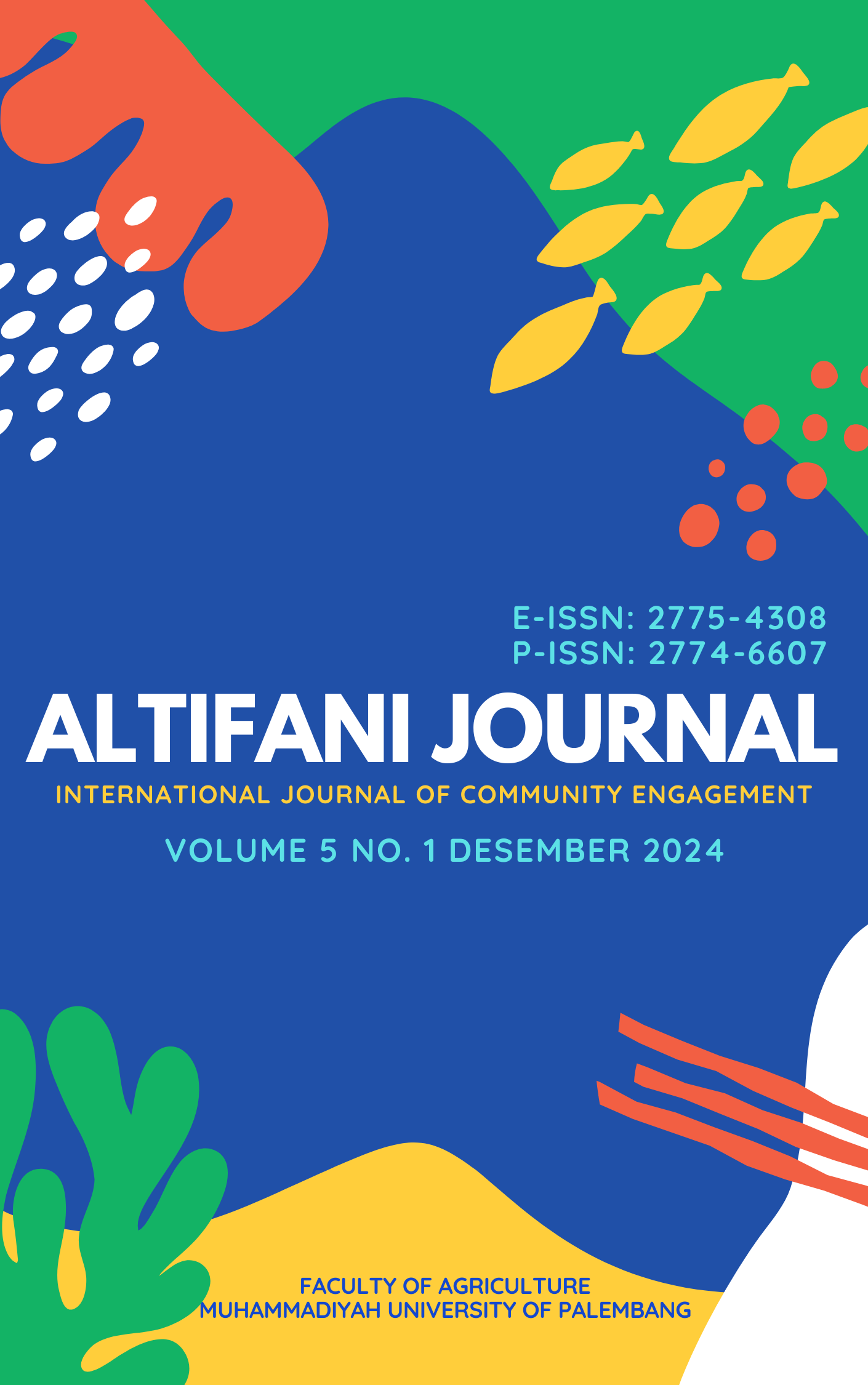Counseling of How to Make Organic Fertilizer Enriched with Phosphate Solubilizing Bacteria to the Community in Tanjung Raja Sub-District
DOI:
https://doi.org/10.32502/altifani.v5i1.276Keywords:
Soil and crop productivity, phosphate-solubilizing bacteria, lowlandAbstract
The village of Talang Balai Baru 1, located in the sub-district of Tanjung Raja in the Ogan Ilir Regency, is characterized by a type of land known as lowland, locally called “lebak” land, which is characterized by low soil fertility. This factor, among others, contributes to a decrease in crop productivity. To address this challenge, it is imperative to employ organic fertilizer in optimal amounts. Specifically, the harvested straw is primarily incinerated, with a limited portion being utilized as chicken manure fertilizer. Despite the abundance of local resources like chicken manure and straw, they are underutilized. Therefore, there is a need to harness these resources for the production of organic fertilizers enriched with phosphate-solubilizing bacteria (PSB). This enriched organic fertilizer is expected to provide essential nutrients to plants and improve soil fertility, thereby boosting soil and crop productivity. The project, conducted from July 29, 2024, to August 27, 2024. The method employed in this study is counseling and socialization regarding the production of BPF-enriched organic fertilizer and its subsequent application by partner farmers. The results of this counseling and socialization demonstrate the high level of support among the residents of Talang Balai Baru 1 Village for this program, as evidenced by their ability to utilize BPF-enriched organic fertilizer on their respective fields. This will contribute to an enhancement in soil and plant productivity.
References
Basuki, B., Sari, V. K. and Tanzil, A. I. (2022) ‘Pelatihan Pemanfaatan Limbah Pertanian Sebagai Pupuk dan Mulsa Organik Bagi Kelompok Tani Harapan Desa Slateng Ledokombo Menuju Zero Waste’, Jurnal Pengabdian Magister Pendidikan IPA, 5(3), pp. 1–6
Campos, P., Borie, F. and Cornejo, P. (2018). Phosporus acquisition effiency related to root traits: is mycorrhizal symbiosis a key factor to wheat and barley cropping?. Frontiers in Plant Science 9(3): 752-760
Dandessa, C., & Bacha, K. (2018). Review on Role of Phosphates solubilizing microorganism in Sustainable Agriculture. International Journal of Current Research and Academic Review, 6 (11), 48–55. https://doi.org/10.20546/ijcrar.2018.611.006
Kalasari R, N Marlina, Marlina, N Husna, Irnady. (2023). Application of Organic Fertilizer Cow Dung and Biofertilizer in Shallots (Allium ascalonicum L.) in Lowland. Jurnal Lahan Suboptimal 12(1):95-101
Ingle, K. P. and Padole, D. A. (2017) “Phosphate Solubilizing Microbes: An Overview,” International Journal of Current Microbiology and Applied Sciences, 6(1), pp. 844–852. doi: 10.20546/IJCMAS.2017.601.099.
Maharajan, T., S.A. Caesar, TPA Krishan, M Ramakrishan, An Abdullah and S Ignacimuthu 2018 “Utilization of molecular markers for improving the phosphorus efficiency in crop plants,” Plant Breeding, 137(1), pp. 10–26. doi: 10.1111/PBR.12537
Marlina, N, Gofar, N., Subakti, A.H.P.K., & Rahim, A.M. (2014a). Improvement of Rice Growth and Productovity Through Balance Application of Inorganic Fertilizer and Biofertilizer in Inceptisol Soil of Lowland Swamp Area. Journal Agrivita. 36(1).48-56
Marlina N, D Meidelima, Asmawati dan IS Aminah. (2018a). Utilization of Different Fertilizer on The Yield of Two Varieties of Oryza sativa in Tidal Lowland Area . Biosaintifika 10(3): 581-587
Marlina, N., Amir, N., Palmasari, B. (2018b). Pemanfaatan Berbagai Jenis Pupuk Organik Hayati terhadap Produksi Bawang Merah (Allium ascalonicum L.) di Tanah Pasang Surut Tipe Luapan C asal Banyuurip. Jurnal Lahan Suboptimal. 7(1).74-79.
Marlina, N., & Gusmiatun. (2020). Ragam Pupuk Hayati untuk Meningkatkan Produktivitas Kedelai di Lahan Lebak. Jurnal Agrosaintek. 4(2).129-136.
Marlina, N., Rosmiah, R., Aminah, I.S., dan Hawayanti, E. (2020). Penyuluhan Pembuatan Pupuk Organik Hayati di Kampung Talang Jawa Kelurahan Pulo Kerto Kota Palembang. Altifani Journal International Journal of Community Engagement. 1(1):36- 39
Marlina N, I Aryani, R Kalasari, Khodijah, Marlina, Asmawati), Y Purwanti, H Nunilahwati, D Meidelima, DT Astuti, Rosmiah, I S Aminah, M Lusia, N Husna, C Aluyah. (2022). Utilization of Agricultural Waste into Organic Fertilizer in Gelebak Dalam Village in Banyuasin Regency. Altifani Journal: International Journal of Community Engagement, 3(1): 31-36
Marlina, N Marlina, H Iswarini, Dali, A Haitami, Khodijah, M H S Wijaya, H Nunilahwati, S Iskandar, S H Syachroni. (2023). Increasing Growth and yield of peanuts with various types and dosages of organic fertilizer in dry land. Juatika 5(2):368-376
Marlina N, Rosmiah, Kl Khotimah,Helmizuryani, B Palmasari, N Amir, J P Rompas, D Meidelima. 2024. The use of organic fertilizer enriched with bacteria to improve the fertility of the soil. Altifani Journal: International Journal of Community Engagement, 4(2): 148-152
Nesme, T., Metson, G. S. and Bennett, E. M. (2018) “Global phosphorus flows through agricultural trade,” Global Environmental Change, 50, pp. 133– 141. doi: 10.1016/J.GLOENVCHA.2018.04.004
Nunilahwati H, N Marlina, Y Purwanti , Asmawati , F Y Zairani, B Hasani, H Kriswantoro, J P Rompas, L Nisfuriah. 2024. Evaluation of Microbe-Enriched Organic Fertilizer on Three Hybrid Corn (Zea Mays L.) Varieties in Swamp Land. Juatika 6(2):267-278
Rosmiah, Aminah, R.I.S., Marlina, N., Dasir, Suyatno, A. Sofian, Okti. 2024. Response of Peanut Plant Varieties (Arachys hypogaea L.) to Administering Biological Organic Fertilizer. Journal of Global Sustainable Agriculture 4(1):101-107
Sharma, S. B., Sayyed, R. Z., Trivedi, M. H., & Gobi, T. A. (2013). Phosphate solubilizing microbes: sustainable Approach form managing phosphorus deficiency in agricultural soil. Springer Plus 2(1):1-14. https://doi.org/10.1186/2193-1801-2-587
Raj, D. P., Linda, R., & Babyson, R. S. (2014). Molecular Characterization of Phospatase solubilizing Bacteria (PSB) and Plant Growth Promoting Rhizobacteria (PGPR) from Pristine soils. International Journal of Inovative Science, Engineering and Technology 1(7): 317–324.
Tajini,F.,Trabelsi,M.,&Drevon,J.J.(2012). Combined inoculation with Glomus intraradices and Rhizobium tropici CIAT 899 increases phosphorus use efficiency for simbiotyc nitrogen fixcation in common bean (Phaseolus vulgaris L.). Saudi of Journal of Biological Sciences 19 (2012): 157-163. https://doi.org/10.1016/j.sjbs.2011.11.003
Zhu, J., Li, M., & Whelan, M. (2018). Phosphorus activator contribute to legacy phosphorus availability in agricultural soils. A Riview . Saince of the total Environment 612, 522–537. https://doi.org/10.1016/j.scitotenv.2017.08.095
Downloads
Published
How to Cite
Issue
Section
License
Copyright (c) 2024 Altifani Journal: International Journal of Community Engagement

This work is licensed under a Creative Commons Attribution 4.0 International License.


















